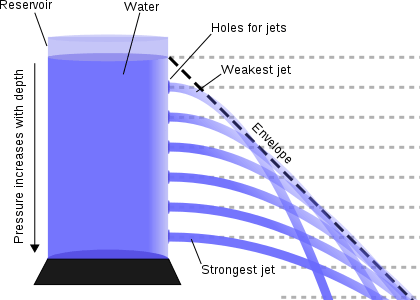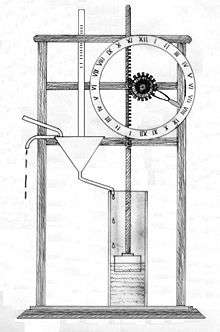Torricelli's law
Torricelli's law, also known as Torricelli's theorem, is a theorem in fluid dynamics relating the speed of fluid flowing from an orifice to the height of fluid above the opening. The law states that the speed v of efflux of a fluid through a sharp-edged hole at the bottom of a tank filled to a depth h is the same as the speed that a body (in this case a drop of water) would acquire in falling freely from a height h, i.e. , where g is the acceleration due to gravity (9.81 m/s2 near the surface of the Earth). This expression comes from equating the kinetic energy gained, , with the potential energy lost, mgh, and solving for v. The law was discovered (though not in this form) by the Italian scientist Evangelista Torricelli, in 1643. It was later shown to be a particular case of Bernoulli's principle.

Derivation
Under the assumptions of an incompressible fluid with negligible viscosity, Bernoulli's principle states that
where is fluid speed, is the acceleration due to gravity (about 9.81 m/s2 on the Earth's surface), is the height above some reference point, is the pressure, and is the density. Thus, for any two points in the liquid,
The first point can be taken at the liquid's surface, and the second just outside the opening. Since the liquid is assumed to be incompressible, is equal to ; both can be represented by one symbol . In addition, when the opening is very small relative to the horizontal cross-section of the container, the velocity of the surface is assumed to be negligible (). is assumed to be practically the same at both points, so .
is equal to the height of the liquid's surface over the opening. and are typically both atmospheric pressure, so .
Experimental evidence
Torricelli's law can be demonstrated in the spouting-can experiment, which is designed to show that in a liquid with an open surface, pressure increases with depth. It consists of a tube with three separate holes and an open surface. The three holes are blocked, then the tube is filled with water. When it is full, the holes are unblocked. The lower a jet is on the tube, the more powerful it is. The fluid exit velocity is greater further down the tube.[1]
Ignoring viscosity and other losses, if the nozzles point vertically upward, then each jet will reach the height of the surface of the liquid in the container.
Horizontal distance covered by the jet of liquid
If h is height of the orifice and H is height of the liquid column, the horizontal distance covered by the jet of liquid to reach the same level as the base of the liquid column can be easily derived.
Using the kinematics equation and consider a point outside the container closed to the orifice see (vena contracta)
- y = vertical distance traveled by a particle of the stream = h,
Velocity of the jet × time taken by the jet to fall H units:
where D is the range of the flow the distance in the horizontal direction.
- by optimization
- plug in H/2 in D(h) to obtain the maximum range
- maximum range = H
Total time to empty the container
Consider a cylindrical container containing water to height h is being emptied through a tube freely. Let h be the height of water at any time. Let the velocity of efflux be
Due to conservation of mass (assuming incompressible flow), where A and a are the cross sections of container and tube respectively, dh is the height of liquid in container corresponding to dx in the tube which decreases in same time dt:
is the time required to empty the water from height h1 to h2 in the container, where h1 > h2. This formula can be used to calibrate a water clock. For a container to be fully drained, is set to 0:
Coefficient of discharge
If one compares the theoretical predictions about the discharge process of a tank with a real measurement, very large differences can be found in some cases. In reality, the tank usually drains much more slowly. In order to obtain a better approximation to the volumetric flow rate actually measured, a discharge coefficient is used in practice:
The coefficient of discharge takes into account both the reduction of the discharge velocity due to the viscous behaviour of the liquid ("coefficient of velocity") and the reduction of the effective outflow cross-section due to the vena contracta ("coefficient of contraction"). For low viscosity liquids (such as water) flowing out of a round hole in a tank, the discharge coefficient is in the order of 0.65[2]. By using rounded pipe sockets, the coefficient of discharge can be increased to over 0.9. For rectangular openings, the discharge coefficient can be up to 0.67, depending on the height-width ratio.
Clepsydra problem

A clepsydra is a clock that measures time by the flow of water. It consists of a pot with a small hole at the bottom through which the water can escape. The amount of escaping water gives the measure of time. As given by the Torricelli's law, the rate of efflux through the hole depends on the height of the water; and as the water level diminishes, the discharge is not uniform. A simple solution is to keep the height of the water constant. This can be attained by letting a constant stream of water flow into the vessel, the overflow of which is allowed to escape from the top, from another hole. Thus having a constant height, the discharging water from the bottom can be collected in another cylindrical vessel with uniform graduation to measure time. This is an inflow clepsydra.
Alternatively, by carefully selecting the shape of the vessel, the water level in the vessel can be made to decrease at constant rate. By measuring the level of water remaining in the vessel, the time can be measured with uniform graduation. This is an example of outflow clepsydra. Since the water outflow rate is higher when the water level is higher (due to more pressure), the fluid's volume should be more than a simple cylinder when the water level is high. That is, the radius should be larger when the water level is higher. Let the radius increase with the height of the water level above the exit hole of area That is, . We want to find the radius such that the water level has a constant rate of decrease, i.e. .
At a given water level , the water surface area is . The instantaneous rate of change in water volume is
From Torricelli's law, the rate of outflow is
From these two equations,
Thus, the radius of the container should change in proportion to the quartic root of its height,
See also
| Wikimedia Commons has media related to Torricelli's Law. |
- Darcy's law
- Dynamic pressure
- Fluid statics
- Hagen–Poiseuille equation
- Helmholtz's theorems
- Kirchhoff equations
- Knudsen equation
- Manning equation
- Mild-slope equation
- Morison equation
- Navier–Stokes equations
- Oseen flow
- Pascal's law
- Poiseuille's law
- Potential flow
- Pressure
- Static pressure
- Pressure head
- Relativistic Euler equations
- Reynolds decomposition
- Stokes flow
- Stokes stream function
- Stream function
- Streamlines, streaklines and pathlines
References
- Spouting cylinder fluid flow.
- tec-science (2019-11-21). "Discharge of liquids (Torricelli's law)". tec-science. Retrieved 2019-12-08.
Further reading
- T. E. Faber (1995). Fluid Dynamics for Physicists. Cambridge University Press. ISBN 978-0-521-42969-6.
- Stanley Middleman, An Introduction to Fluid Dynamics: Principles of Analysis and Design (John Wiley & Sons, 1997) ISBN 978-0-471-18209-2
- Dennis G. Zill (14 May 2008). A First Course in Differential Equations. Cengage Learning. ISBN 978-0-495-10824-5.